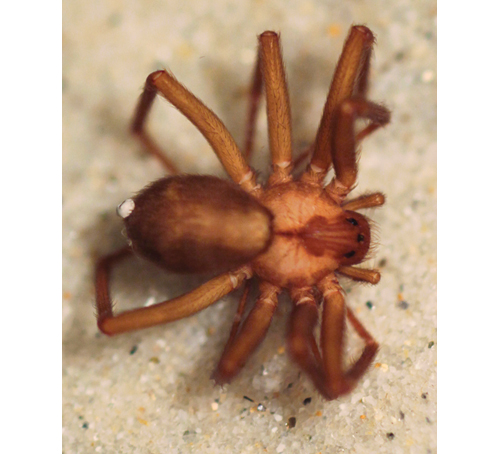Spider sightings lead to venomous tales on the North Fork

There’s been a spider scare out in Greenport, just in time for Halloween.
But local experts say the chances of finding a venomous brown recluse spider on the North Fork are about as good as seeing a witch fly across the lighted moon.
This tale begins in Erin and Chris Doucett’s house on Sound Road.
The family had been struggling to rid a finished basement of persistent brown spiders, Ms. Doucett told The Suffolk Times, and tried fumigation, setting glue traps and the use of both eucalyptus and orange oils.
And despite what the experts say, she believes the invading arachnids — which are now gone — were indeed brown recluse spiders, or Loxosceles reclusa, which are infamous for highly toxic venom. Though the spider rarely bites, some extreme reactions to bites have resulted in necrotized flesh and limb amputations.
That was enough to put the Doucetts and some of their neighbors on Sound Road and parallel Sunset Lane on high alert over the last few weeks, with at least two homeowners having called in an exterminator to fumigate.
When told of the spider rumors, entomologist Scott Campbell of the Suffolk County Department of Health Services insisted there’s nothing to worry about; there hasn’t been one confirmed brown recluse sighting in Suffolk County to date.
Between 2000 and 2005, Dr. Campbell sent about 20 spider specimens to Long Island native Rick Vetter, a professor at the University of California, Riverside, who conducted a five-year national study to investigate, among other things, claims that the territory of the brown recluse spider had spread to Long Island.
Answering this question became all the more important after a Newsday article about three brown recluse bites that occurred on Long Island in 2003, Dr. Campbell said.
“That 2003 article drove people to send me dozens of spider specimens, which I passed along to Rick,” Dr. Campbell said, “Not one specimen of brown recluse spider was found outside of their habitat region or have become established there.”
Ms. Doucett believes her spider problem started with the family’s purchase of a new couch. It was shortly after the couch was delivered, she said, that the spiders appeared.
She added that when the family began sleeping upstairs, they began seeing spiders there as well.
“I don’t know if we brought them up with the blankets,” she said, “but it was just a terrible experience because we have three children and for a while there, we thought everything was a brown recluse spider bite.”
Dr. Campbell said the possibility of brown recluse spiders being shipped outside of their habitat region exists, but is “very unlikely.”
He encouraged those curious about the brown recluse spider to visit http://spiders.ucr.edu/brs.html to see results of the five-year national study and learn more about the spider, including how to better identify it.
Dr. Campbell attributed the increase in calls about brown recluse spiders may be connected to a recent proliferation of spiders in general.
“This fall seems to be a banner year for some of these garden spiders,” Dr. Campbell said. “The webs are everywhere and people are seeing these big spiders and are saying they’re brown recluses for reasons not based in science. It seems when a person sees a spider that looks kind of frightening it’s a brown recluse.”
He added that though he can’t say “definitely” that there aren’t brown recluse spiders in Suffolk County or on the North Fork, the chances are “very very very very very slim.”
Indigenous to the South and Midwest, the brown recluse is also often called a “violin spider” as they have a black violin-like marking on their cephalothorax, where the legs attach, according to the University of California study.
The “neck” of the violin points toward the back of the spider. In addition to this violin marking, the spider has six eyes arranged in pairs, rather than eight. The brown recluse is usually found not outside, but in basements or quiet, undisturbed corners, prefers to feed on dead insects at night and does not make a classic wheel-shaped web, but a rather loose, messy web created out of sight.
Officials at Eastern Long Island Hospital in Greenport said they have no records of treating brown recluse spider bites.
Entomologist Dan Gilrein at Cornell Cooperative Extension of Riverhead said that though he wouldn’t be surprised if the spiders could survive here over a winter indoors, neither he nor the organization’s diagnostic lab had a confirmed brown recluse inquiry.
“I realize that it’s spoken a lot about and people insist they’re here, but we have never seen a sample,” Mr. Gilrein said.








